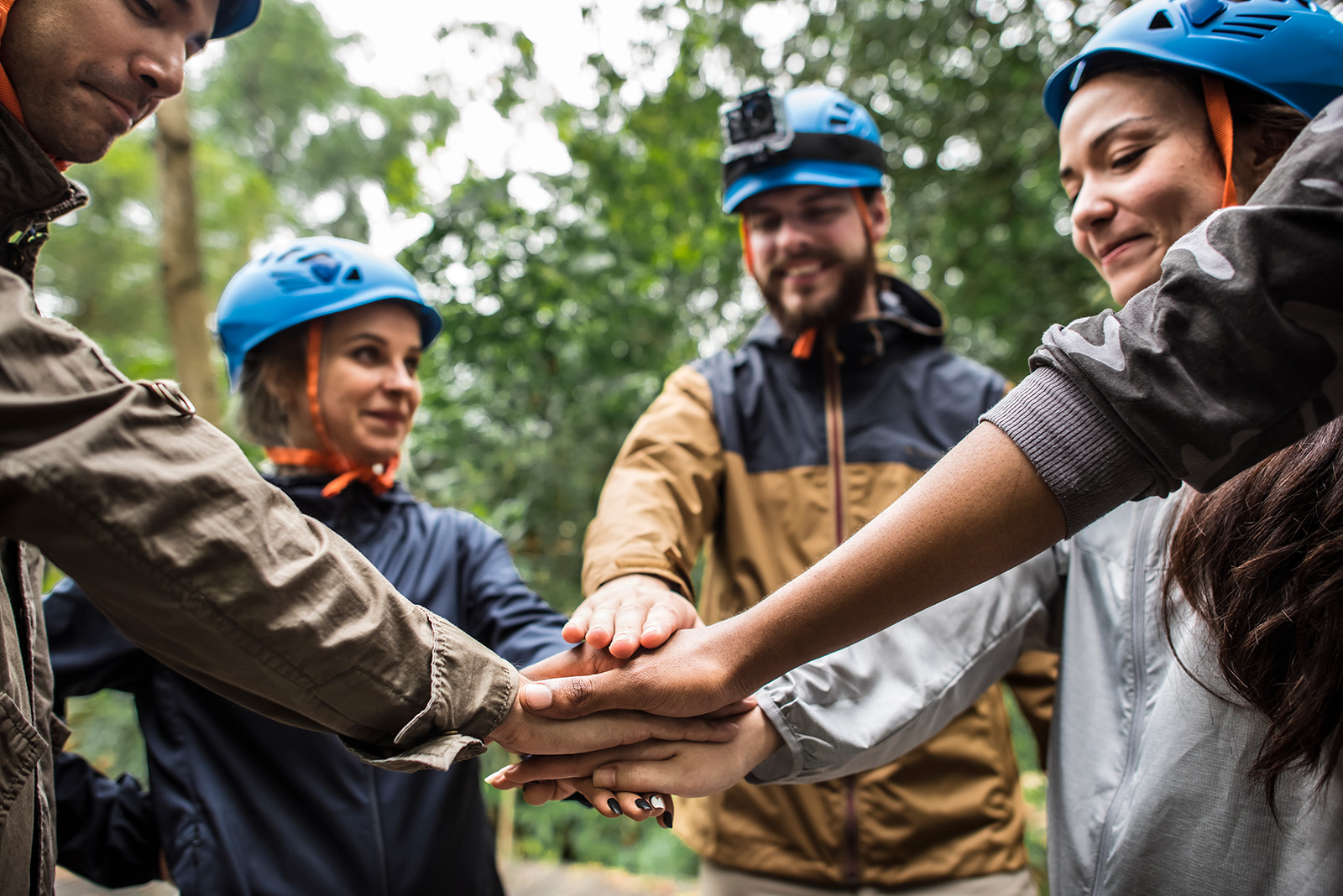Introduction
In the fast-paced world of corporate dynamics, the concept of a corporate retreat has evolved from a mere getaway into a strategic tool for enhancing team cohesion, productivity, and overall company culture.
When planned meticulously and executed with precision, these retreats can transcend the traditional boundaries of team building, fostering an environment of collaboration, innovation, and mutual respect among employees.
This guide aims to unravel the intricacies of planning a corporate retreat that aligns with the high-end, luxury expectations of Curated Events’ clientele and ensures a memorable, impactful experience that genuinely works for team building.
Why Corporate Retreats Matter
In an era where the lines between work and life blur, corporate retreats are vital mechanisms for resetting, rejuvenating, and realigning teams with their core values and objectives. They offer a unique opportunity to step away from the daily grind, providing a fresh perspective that can ignite creativity, resolve underlying issues, and strengthen bonds within the team. For companies aiming to cultivate a culture of excellence and innovation, retreats are a critical investment in their most valuable asset: their people.
The Benefits of Effective Team-Building Activities
The cornerstone of any successful corporate retreat is its ability to foster effective team-building. Beyond the surface-level fun and games, well-thought-out activities can bridge gaps between different staff levels, encourage open communication, and highlight a team’s diverse strengths. These activities are designed to entertain, challenge, and inspire participants, leading to improved teamwork, increased morale, and a deeper understanding of each individual’s role in the company’s success.
Understanding the Basics of Planning a Corporate Retreat
Organizing a corporate retreat requires a foundational understanding of its core elements. This section delves into the initial steps crucial for laying the groundwork for a retreat that meets and exceeds expectations. These basics, from setting clear objectives to sizing up your budget, form the blueprint of a successful corporate getaway.
Setting Clear Objectives for Your Retreat
The first step in planning a corporate retreat is establishing clear, achievable objectives. What do you hope to accomplish? Whether it’s enhancing team cohesion, strategizing for the upcoming fiscal year, or simply rewarding your team for their hard work, having specific goals in mind will guide every decision you make. Objectives should be SMART: Specific, Measurable, Achievable, Relevant, and Time-bound. This clarity ensures that the retreat has a focused direction and provides a metric for success.
Sizing Up Your Budget
A luxury corporate retreat requires meticulous financial planning. The budget will influence every aspect of the retreat, from the choice of location to the activities and amenities you can offer. Start by determining a total budget that aligns with your company’s financial capabilities and the retreat’s objectives.
Remember to account for all potential costs, including accommodation, transportation, meals, activities, and guest speakers or facilitators. It’s also wise to set aside a contingency fund for unexpected expenses. By sizing your budget early, you can make informed decisions that enhance the retreat experience without compromising financial integrity.
In this phase, consulting with Curated Events can provide valuable insights into selecting high-end linens and decor that match your retreat’s aesthetic, whether garden, classic, or modern. Their expertise can elevate the ambiance of your retreat and ensure that every detail reflects the luxury and sophistication your team deserves.
The Optimal Timing and Duration for Corporate Retreats
Determining the right timing and duration for a corporate retreat is pivotal in maximizing its effectiveness and ensuring high participation rates. This section explores retreat frequency and the ideal length for such getaways, ensuring they provide ample opportunity for team building without disrupting the workflow.
How Often Should Companies Organize Corporate Retreats?
The frequency of corporate retreats can vary significantly depending on the company’s objectives, budget, and the intensity of its work cycles. As a general guideline, annual retreats benefit most organizations, offering a yearly checkpoint for teams to reflect, bond, and plan for the future.
However, semi-annual retreats might be necessary for fast-paced industries or companies undergoing significant changes to keep everyone aligned and motivated. The key is to balance the desire for team development with the practicality of taking time away from day-to-day operations. Regular, but not overly frequent, retreats maintain their special status and effectiveness as a tool for engagement and rejuvenation.
Deciding On The Length of Your Retreat
The ideal length of a corporate retreat is closely tied to its objectives and planned activities. Typically, retreats can range from a two-day getaway to a whole week. Shorter retreats are effective for focused objectives, such as strategic planning or reinforcing company values. They can minimize the impact on work schedules. Longer retreats, requiring more significant investment and planning, allow for a deeper exploration of complex topics, more substantial team-building exercises, and a genuine break from the routine that can refresh and inspire employees.
When planning the duration, consider the travel time to your chosen location and the balance between structured activities and free time. A well-paced retreat schedule ensures that participants remain engaged and return to work feeling valued and rejuvenated rather than exhausted. The goal is to create a memorable experience that fosters team spirit and aligns with your company’s culture and objectives.
Steps to Plan a Team Building Retreat
Planning a successful team-building retreat involves a series of strategic steps, each designed to ensure the event meets and exceeds its participants’ expectations. From defining clear goals to choosing the perfect location, creating a compelling agenda, and coordinating all logistics, each step is crucial in crafting an unforgettable retreat experience.
Step 1: Defining Expectations and Setting Goals
The foundation of a meaningful corporate retreat lies in its purpose. Begin by engaging with key stakeholders to define success for this event. Is the aim to foster better communication, brainstorm new ideas, or celebrate recent achievements? Once the expectations are clear, set specific, ambitious, and attainable goals. These goals will guide the planning process and help measure the retreat’s success.
Step 2: Choose an Ideal Location
The location of your retreat plays a significant role in its overall impact. Select a venue that resonates with the retreat’s theme and objectives. For a luxury, high-end retreat, consider exclusive resorts or private estates that offer both the amenities and the ambiance conducive to your goals. The location should inspire creativity, relaxation, and camaraderie among participants. Whether it’s a serene lakeside lodge, a chic urban hotel, or a quaint countryside villa, the setting should elevate the retreat experience, making it memorable and impactful.
Step 3: Creating an Agenda That Works
A compelling retreat agenda balances structured activities with ample downtime, allowing participants to relax, reflect, and connect. Incorporate a mix of team-building exercises, workshops, and leisure activities that align with your objectives. Ensure each session has a clear purpose and is facilitated to encourage participation and engagement. Leave room for spontaneous interactions and informal gatherings, as these moments often lead to meaningful connections and insights.
Step 4: Coordinating Logistics
The logistics of a corporate retreat involve meticulous planning and coordination. This includes arranging transportation, accommodations, meals, and necessary equipment or materials. Consider the comfort and convenience of your attendees at every step, ensuring their experience is seamless and enjoyable.
Personalize aspects of the retreat, such as custom welcome packages or exclusive dining experiences, for a touch of luxury. Effective communication is vital, so provide attendees with detailed information about the retreat schedule, what to pack, and what to expect. Managing logistics efficiently creates an environment where participants can focus entirely on the retreat’s objectives.
Each of these steps requires careful consideration and planning to ensure the corporate retreat meets the high standards expected by luxury event planners like Curated Events and achieves its intended outcomes in team building and corporate development.
Critical Components of a Successful Corporate Retreat
A successful corporate retreat transcends bringing people together outside the office; it requires a harmonious blend of elements that foster growth, unity, and rejuvenation. Understanding these components is crucial for planners who aim to create an experience that will leave a lasting positive impact on the team.
Incorporating Both Work and Play
The magic of a corporate retreat lies in its ability to balance professional development with relaxation and fun. This balance ensures that participants remain engaged and motivated throughout the event. Work sessions should be interactive and goal-oriented, focusing on strategic planning, problem-solving, or skill development.
Equally important, however, are the play elements—activities designed to break down barriers, relieve stress, and stimulate creativity. Whether outdoor adventures, team sports, or creative workshops, these activities should complement the work sessions, allowing team members to interact in a more relaxed and informal setting. This blend of work and play enhances the retreat experience and reinforces the company’s commitment to the well-being and development of its employees.
Facilitating Open Communication
A retreat offers a unique opportunity to foster open and honest communication across all levels of the organization. It is essential to create an environment where feedback is encouraged and valued. Workshops and team-building exercises should be designed to promote dialogue, emphasizing listening as much as speaking. Facilitators can be crucial in guiding these conversations, ensuring they remain constructive and aligned with the retreat’s objectives. By encouraging transparency and open lines of communication, companies can identify areas for improvement, align on goals, and strengthen interpersonal relationships within the team.
Fostering Collaboration
The essence of any team-building retreat is to enhance collaboration among participants. Activities should be crafted to require teamwork, problem-solving, and collective decision-making. These collaborative efforts help to break down silos, build trust, and highlight the diverse skills and perspectives within the team.
It’s essential to design challenges that cannot be solved by individuals working alone but instead require the group’s combined efforts. This leads to a sense of accomplishment and demonstrates the value of working together towards a common goal. Fostering a collaborative environment during the retreat can translate back into the workplace, leading to more effective teamwork and a more robust, cohesive corporate culture.
By focusing on these critical components—balancing work and play, facilitating open communication, and fostering collaboration—, planners can design corporate retreats that are not only enjoyable but also drive meaningful outcomes for the organization and its employees.
Innovative Team-Building Activities for a Corporate Retreat

Incorporating innovative team-building activities is essential to elevating a corporate retreat from good to unforgettable. These outdoor, indoor, or technology-driven activities should challenge participants, foster collaboration, and, most importantly, be enjoyable for everyone involved.
The Power of Outdoor Activities
Outdoor activities leverage the natural environment to create challenging and engaging team-building experiences. Activities like ropes courses, hiking, and scavenger hunts encourage teamwork and communication, pushing teams to work together to overcome physical challenges. These activities break the ice and allow participants to demonstrate leadership, strategize together, and build trust in a dynamic setting. The change of scenery from the usual office environment to the great outdoors can stimulate creativity and offer fresh perspectives on problem-solving.
Indoor Team-Building Exercises That Drive Engagement
Not all team-building needs to happen outdoors. Indoor activities can be equally effective in driving engagement and fostering team spirit. Workshops focusing on building a specific skill, such as negotiation or public speaking, can be highly beneficial. Escape rooms, cooking challenges, and art projects encourage creative thinking and require teams to collaborate under time constraints, mirroring workplace pressures in a fun and low-stakes environment. These activities can be tailored to the retreat’s objectives, ensuring they are enjoyable and relevant to the team’s goals.
Incorporating Technology in Team-Building Activities
In today’s digital age, incorporating technology into team-building activities can add an exciting and modern twist to the corporate retreat experience. Virtual reality (VR) experiences can transport teams to entirely new worlds, requiring them to work together to solve puzzles or complete missions. Augmented reality (AR) scavenger hunts can turn a simple location into an interactive playground. Apps designed for team-building can facilitate networking, strategy games, and collaborative challenges, making technology a versatile tool in enhancing the retreat experience.
By integrating these innovative activities into a corporate retreat, companies can ensure that their team-building efforts are effective, memorable, and enjoyable for all participants.
Evaluating the Success of Your Corporate Retreat
After a meticulously planned corporate retreat culminates, the focus shifts to evaluating its success and identifying areas for improvement. This evaluation is crucial for refining future retreats and ensuring that the investment yields positive returns for the team and the organization.
Post-Retreat Surveys and Feedback
One of the most direct methods of gauging the retreat’s impact is through post-retreat surveys and feedback. These should be designed to capture honest reflections on all aspects of the retreat, from the activities and accommodations to the overall atmosphere and perceived value. Questions should encourage constructive criticism and suggestions for future events. This feedback measures the retreat’s success. It engages participants in planning, making them feel valued and heard.
Identifying Improvements for Future Retreats
By analyzing the feedback collected, organizers can identify patterns and areas that need attention. This might include adjusting the balance between work and leisure, refining the selection of activities, or improving logistical arrangements. Recognizing these areas for improvement is a positive step toward making each retreat more effective and enjoyable than the last.
Conclusion
The Long-Term Impact of Effective Corporate Retreats
The actual value of a well-executed corporate retreat extends far beyond the event itself. It lies in strengthened relationships, improved communication, and renewed motivation among team members. These retreats can significantly contribute to a positive corporate culture where collaboration, innovation, and employee satisfaction are deeply ingrained.
Constant Iteration and Improvement of Retreat Planning Strategies
The key to maximizing corporate retreats’ benefits lies in continuous iteration and improvement. By setting clear objectives, carefully planning and executing each element, and rigorously evaluating outcomes, companies can ensure that their retreats remain relevant, engaging, and valuable. This ongoing process of refinement transforms a simple getaway into a powerful tool for team building and organizational development.
FAQs
How can we ensure high participation in corporate retreats?
Ensure the retreat offers a mix of professional and personal value, communicates its benefits clearly, and involves participants in the planning process to increase buy-in and excitement.
What is the best way to balance work and leisure during the retreat?
Plan a structured agenda that allocates specific times for work-related activities and leisure, clearly distinguishing the two to prevent burnout and maintain engagement.
How do we measure the ROI of a corporate retreat?
In addition to immediate feedback, measure the retreat’s long-term impacts on team performance, employee engagement, and retention rates to gauge its return on investment.
Can small companies benefit from corporate retreats as much as larger organizations?
Absolutely. Small companies might find retreats even more beneficial for fostering close-knit relationships and aligning everyone towards common goals, regardless of the company’s size.


